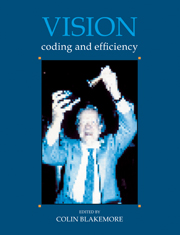Book contents
- Frontmatter
- Contents
- List of Contributors
- Preface
- Reply
- Acknowledgements
- Concepts of coding and efficiency
- Efficiency of the visual pathway
- Colour
- 11 The two subsystems of colour vision and their rôles in wavelength discrimination
- 12 The effect of the angle of retinal incidence on the color of monochromatic light
- 13 Fourier Interferometric Stimulation (FIS): the method and its applications
- 14 The chromatic coding of space
- Brightness, adaptation and contrast
- Development of vision
- Depth and texture
- Motion
- From image to object
- Index
13 - Fourier Interferometric Stimulation (FIS): the method and its applications
Published online by Cambridge University Press: 05 May 2010
- Frontmatter
- Contents
- List of Contributors
- Preface
- Reply
- Acknowledgements
- Concepts of coding and efficiency
- Efficiency of the visual pathway
- Colour
- 11 The two subsystems of colour vision and their rôles in wavelength discrimination
- 12 The effect of the angle of retinal incidence on the color of monochromatic light
- 13 Fourier Interferometric Stimulation (FIS): the method and its applications
- 14 The chromatic coding of space
- Brightness, adaptation and contrast
- Development of vision
- Depth and texture
- Motion
- From image to object
- Index
Summary
History and basics
In order to describe the efficiency of a physiological system it is important to know its transfer characteristics for complex stimuli. It is not necessary to measure the reaction of the system for stimuli of every possible time-course. If a system can be linearly approximated, one can restrict oneself to the transfer characteristics for sinusoidal stimuli. All other stimulus time-courses can be represented as a sum of sine shaped components of varying amplitude and phase. Hearing can be tested with pure tones, and the spatial resolution of the eye is examined with spatial gratings that are modulated sinusoidally in brightness.
In principle, colour vision could be analogously examined with spectral lights that have sine shaped spectral energy distribution. Newton used rectangular ‘comb spectra’, and Barlow (1982) explained how comb spectra with a sinusoidal modulation of energy with wavelength can be used for the analysis of colour vision.
In 1969 R. Gemperlein came across a paper about a Fourier interferometer working in the infrared region of the spectrum, and he had the idea of using an interferometer for the visible and ultraviolet spectral region as a spectral modulator for a light source for the examination of the visual system. After preliminary experiments and discussions with various commercial firms in 1974, the realization of this idea started in 1976 based on a doctoral thesis in the physics department of the Technische Universität in Munich. Here Heinz Parsche had constructed a Fourier spectrometer for the visible and UV spectral region. With this instrument Riidiger Paul, while working on his diploma, proved the possibility of realizing this idea, with Parsche's support.
- Type
- Chapter
- Information
- VisionCoding and Efficiency, pp. 142 - 149Publisher: Cambridge University PressPrint publication year: 1991



